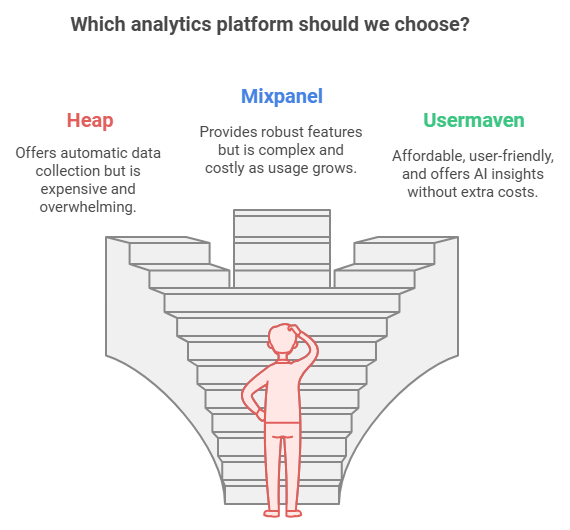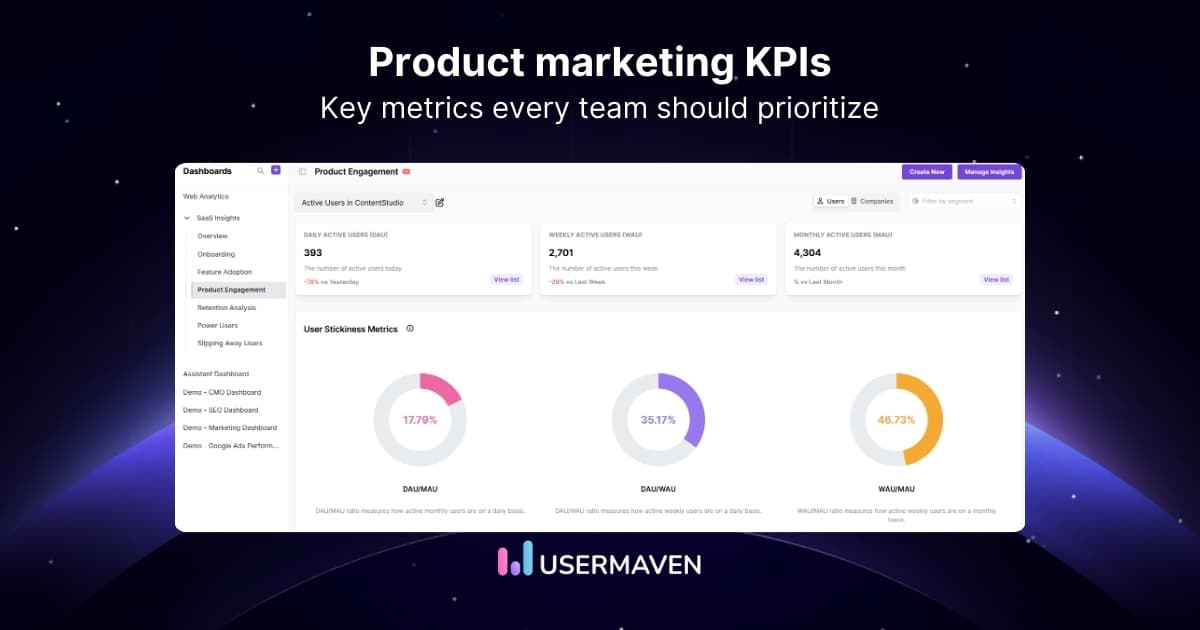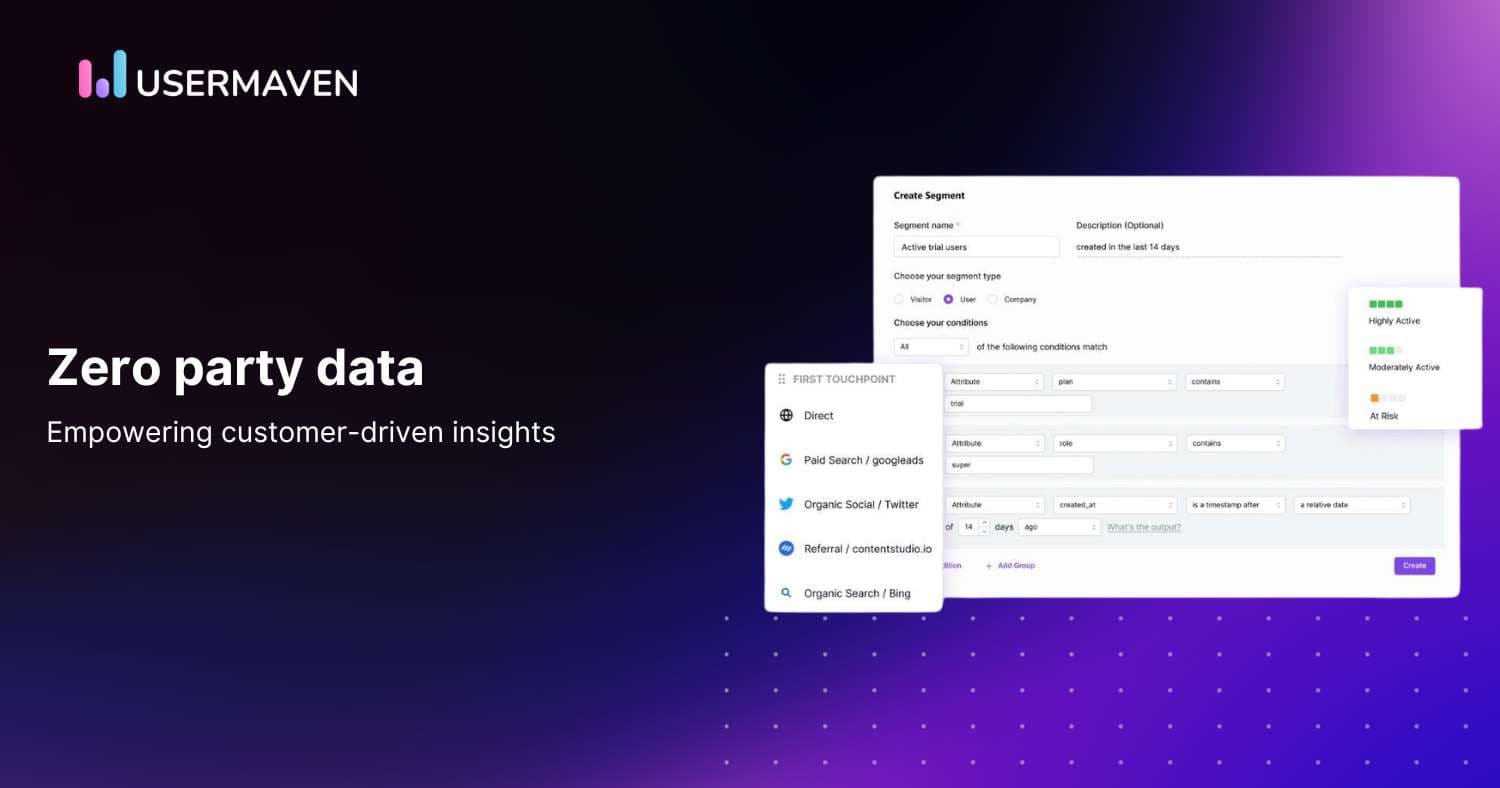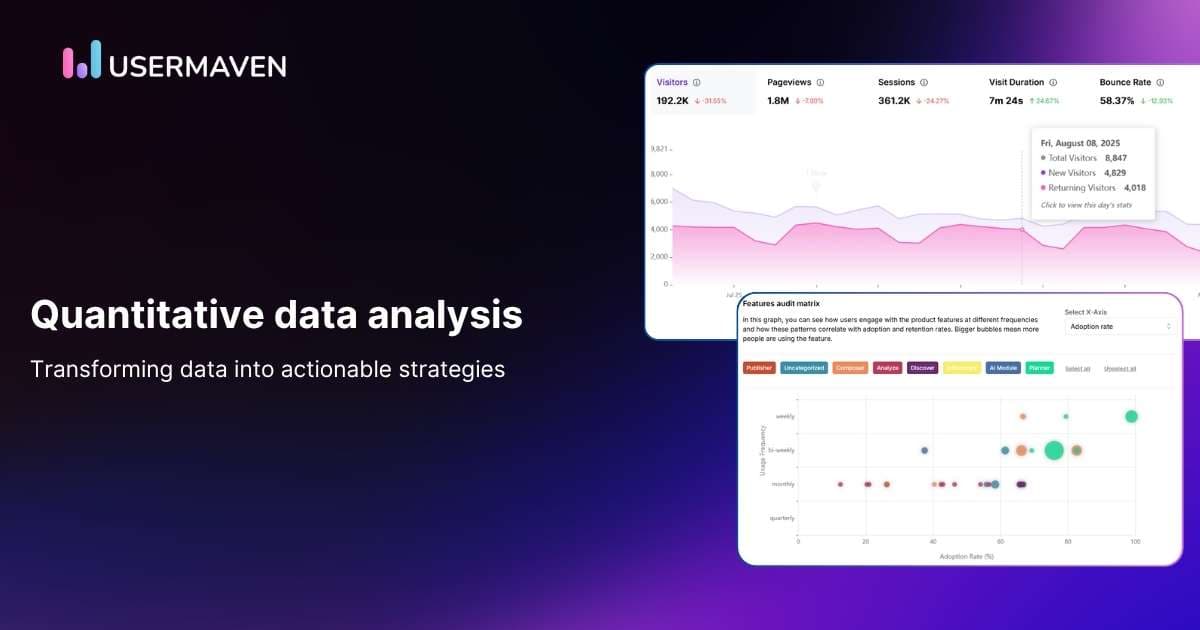Beyond the price tag: Heap vs. Mixpanel vs. Usermaven – A true analysis
Nov 22, 2024
5 mins read
Written by Mahnoor Shahid

Choosing the right analytics platform can feel overwhelming, especially when each tool promises to be the best. But let’s be honest – some platforms come with their own challenges.
Heap’s “capture everything” approach sounds great in theory, but it can quickly lead to data overload, making it hard to find the insights you actually need. Mixpanel, while powerful for tracking user behavior, often requires technical expertise to unlock its full potential, and scaling costs can catch you off guard.
This is where Usermaven stands out. With its focus on simplicity, affordability, and actionable insights, Usermaven offers a balanced solution that’s easy to use and designed to meet the needs of growing businesses.
Let’s take a closer look at how these platforms compare Heap vs. Mixpanel vs. Usermaven to help you decide which one is the right fit for your business.
Overview: Heap vs. Mixpanel vs. Usermaven

Known for automatic data collection, Heap tracks everything without needing predefined events. However, its expensive paid plans start at $3,600 per year, lacks AI-powered insights and attribution modeling, and often overwhelms teams with too much data that’s hard to turn into actionable insights.
A leader in behavioral analytics, Mixpanel offers robust features but is complex to use. While its price is $70.56/month for 100K events, it can quickly rise to thousands as your usage grows. Many advanced features require costly upgrades, making them less affordable over time.
A modern, affordable solution starting at $14/month with a pro plan at $49/month. It offers AI-powered insights, attribution modeling, and unlimited funnel analysis without extra costs. Usermaven is user-friendly, privacy-focused, and delivers enterprise-grade analytics at a fraction of the cost of competitors.
Privacy and data accuracy

Usermaven takes a privacy-first approach, built from the ground up with GDPR and CCPA compliance in mind. Their cookieless tracking option provides flexibility for privacy-conscious organizations. The platform ensures data accuracy through multiple tracking methods, maintaining 99% accuracy even with ad blockers. With unlimited data retention and complete data ownership, Usermaven gives organizations full control over their analytics data while maintaining privacy compliance.
Heap’s automatic data collection system captures every user interaction on your website. While comprehensive, this approach raises some privacy concerns in regions with strict data protection laws. The platform stores all collected data on its servers, with retention periods limited to 1 year and pay more for longer. This can impact long-term historical analysis capabilities. Users have reported significant data loss due to ad blockers, which can affect up to 40% of traffic in some regions. Heap attempts to mitigate this through various tracking methods, but accuracy remains a challenge.
Mixpanel offers more granular control over data collection, allowing teams to specify exactly what data they want to track. This selective approach helps with privacy compliance but requires careful setup. The platform provides custom data retention options and allows organizations to choose their data storage location. However, it still relies heavily on cookies for user identification. With moderate ad blocker impact, Mixpanel maintains relatively good data accuracy. Their server-side tracking options help minimize data loss, though implementation requires technical expertise. Exploring tools for server-side tracking can further enhance data reliability and accuracy by capturing user interactions directly from the server, reducing dependency on client-side scripts.
| Feature | Usermaven | Heap | Mixpanel |
| Privacy compliance | GDPR & CCPA | Limited | Limited |
| Data accuracy | Maintains 99% accuracy | Moderate loss with blockers | Moderate loss with blockers |
| Data retention | Unlimited | 1 year | 5 years |
| Cookie dependency | Cookieless | Required | Required |
Ease of use and implementation

Usermaven emphasizes quick implementation with automatic event tracking that can be set up in minutes. The no-code approach makes it accessible to teams of all technical levels. The modern, clean interface focuses on usability without sacrificing functionality. Common analytics tasks are streamlined through intuitive workflows. With minimal technical expertise required, teams can start gathering insights immediately after installation.
Heap’s automatic tracking requires minimal initial setup but needs significant effort to organize and interpret the collected data. The platform captures everything, which can be overwhelming for new users. The interface, while powerful, can be complex to navigate. Users often need technical expertise to create meaningful segments and analyze data effectively. Teams typically spend several days setting up Heap properly, including customizing event definitions and establishing tracking parameters.
Mixpanel’s implementation requires careful planning and setup of manual event tracking. This approach ensures clean data but demands more upfront work. The platform offers powerful analysis tools but comes with a steep learning curve. New users often need training to utilize their full capabilities effectively. Technical teams appreciate Mixpanel’s detailed documentation and robust API, though non-technical users may find the interface challenging.
| Feature | Usermaven | Heap | Mixpanel |
| Setup time | Minutes | Minutes | Hours |
| Event tracking | Automatic | Auto-capture (default) | Manual |
| Learning curve | Gentle | Moderate | Steep |
| Interface | Modern and clean | Basic | Complex |
Attribution modeling and user insights

Usermaven features seven comprehensive attribution models powered by AI, including advanced multi-touch attribution. The system automatically identifies and weights important touchpoints. The platform offers an industry-leading 180-day lookback window, ideal for understanding long-term customer journeys. AI-powered insights automatically highlight significant patterns and attribution trends, making it easier for marketers to understand campaign effectiveness.
Heap notably lacks built-in attribution modeling capabilities, creating a significant gap for marketing teams trying to understand their channel effectiveness. For organizations needing attribution insights, this means either exporting data to other tools or investing in additional third-party solutions, increasing both costs and complexity. This limitation forces teams to either work without attribution data or create complex workarounds, making it difficult to make data-driven marketing decisions.
Mixpanel provides advanced attribution models, including linear, time-decay, and custom attribution. Their behavioral analytics strength shines in understanding user touchpoints. With a 60-day lookback window, Mixpanel captures more of the customer journey. The platform offers flexible channel definitions and custom conversion events. The platform includes limited machine learning capabilities for attribution insights, though most analysis requires manual configuration.
| Feature | Usermaven | Heap | Mixpanel |
| Attribution models | 7 models (AI-powered) | Not available | Basic |
| Lookback window | 180 days | No | 30 days by default |
| Customer insights | Detailed AI insights | No | Yes |
Funnel and journey analysis

Usermaven combines traditional funnel analysis with AI-powered insights to automatically identify optimization opportunities and unusual patterns. It offers a comprehensive view of funnel performance, including conversion rates, channel, source, geographic, and device insights, as well as AI-driven recommendations for improvement. The platform also features AI funnel suggestions, which provide data-driven recommendations for optimizing conversion paths, allowing businesses to easily create, edit, and analyze custom funnels for better performance.
Heap’s automatic data collection enables retroactive funnel creation, allowing teams to analyze historical user journeys without prior setup. The platform provides basic visualization tools for funnel analysis, though creating custom funnels requires some technical knowledge. Drop-off analysis is manual, requiring teams to dig through data to identify conversion obstacles.
Mixpanel excels in funnel analysis with robust visualization tools and detailed user path analysis. Teams can create unlimited custom funnels. The platform offers advanced segmentation capabilities within funnels, helping identify specific user behaviors and patterns. Automated drop-off analysis helps identify major conversion barriers, though insights are primarily based on statistical analysis rather than AI.
| Feature | Usermaven | Heap | Mixpanel |
| Funnel analysis | AI-powered | Manual setup required | Manual setup required |
| User journey mapping | Detailed | Limited | Advanced |
| Drop-off insights | AI-powered | Manual | Manual |
AI capabilities in analytics

Usermaven integrates AI throughout its core functionality, including an AI chatbot for instant analytics assistance and automated insights generation. The platform’s AI capabilities extend across attribution analysis, funnel optimization, and user journey mapping, providing automated recommendations and predictions. AI-powered features are designed to be practical and actionable, focusing on delivering insights that directly impact business decisions.
Heap’s approach to analytics remains traditional, focusing on data collection and manual analysis rather than AI-powered insights. While the platform offers some automated reporting features, it lacks true AI capabilities for predictive analytics or automated insights. Teams must rely on manual analysis and interpretation of the collected data, though the comprehensive data collection provides a solid foundation for external AI tools.
Mixpanel has begun incorporating basic AI features, primarily focusing on anomaly detection and simple predictive analytics. The platform offers some automated insights for cohort analysis and user behavior patterns, though these are relatively basic compared to newer AI-focused tools. Machine learning capabilities are limited to specific features and don’t extend across the entire platform’s functionality.
| AI capabilities | Usermaven | Heap | Mixpanel |
| AI chatbot | Yes | No | Yes |
| AI attribution analysis | Yes | No | Limited |
| AI funnel insights | Yes | No | Basic |
| AI journey analysis | Yes | No | Limited |
Pricing and value

Usermaven provides comprehensive features starting at $14/month with 100K events included. The pricing structure is transparent, with most features available in all tiers. The platform minimizes hidden costs by including AI features and advanced capabilities in base pricing. Implementation costs are minimal due to automatic setup. Full support is included at all tiers, providing better value for organizations of all sizes.
Heap’s paid plans start at $3,600 annually, targeting enterprise customers with comprehensive data collection needs. The high starting price can be a barrier for smaller organizations. Additional costs often arise from implementation, training, and accessing advanced features. The unlimited event collection is valuable but comes at a premium. Enterprise support is available but typically requires higher-tier plans, making the total cost of ownership significant.
Mixpanel has pricing based on monthly tracked users (MTU). This can scale quickly for high-traffic websites. The platform’s tiered pricing structure means some advanced features are only available in higher-priced plans, requiring careful consideration of needed functionality. Support levels vary by plan, with basic support included but premium support requiring additional investment.
| Feature | Usermaven | Heap | Mixpanel |
| Starting price | $14/month | Custom pricing | $70.56/month |
| Event allowance | 100K events | Unlimited | 100K events |
| Support | Full support | Limited to enterprise | Limited |
Real-world applications
For marketing teams
- Heap: Behavioral insights for campaign optimization.
- Mixpanel: Advanced cohort analysis for targeted marketing.
- Usermaven: Comprehensive campaign tracking and AI-driven attribution.
For product teams
- Heap: Auto-captured data for feature performance tracking.
- Mixpanel: Retention and churn analysis.
- Usermaven: Automated feature adoption analytics and retention tracking.
For business owners
- Heap: Basic user behavior insights.
- Mixpanel: Metrics for product-led growth.
- Usermaven: AI-driven insights and full-feature analytics at an affordable price.
Which platform should you choose?
If you’re looking for a platform that offers the best combination of ease of use, advanced analytics, and strong privacy compliance, Usermaven is your ideal choice. While Heap and Mixpanel cater to specific needs, Usermaven excels as a versatile solution that delivers powerful insights without unnecessary complexity. For organizations wanting comprehensive analytics with maximum value, Usermaven is the clear winner.
Make data-driven decisions
faster with Maven AI
*No credit card required
FAQs
1. What makes Usermaven stand out among analytics platforms?
Usermaven balances ease of use, advanced analytics, and privacy compliance at an affordable price. With features like AI-powered insights, automatic event tracking, and comprehensive attribution models, it provides enterprise-grade analytics without the complexity or high costs of other platforms.
2. How does Usermaven ensure privacy compliance and data accuracy?
Usermaven offers cookieless tracking and adheres to GDPR and CCPA regulations. It ensures 99% data accuracy, even with ad blockers, by using advanced tracking methods and providing organizations with complete control over their data.
3. Can Usermaven handle attribution modeling?
Yes, Usermaven includes seven AI-powered attribution models with a 180-day lookback window, helping businesses understand and optimize customer journeys effectively.
4. How easy is it to set up Usermaven compared to Heap and Mixpanel?
Usermaven’s automatic event tracking enables setup in minutes, requiring no technical expertise. In contrast, Heap’s auto-capture requires significant post-setup organization, and Mixpanel demands manual event tracking, which is time-consuming and technical.
5. What is the cost difference between Usermaven, Heap, and Mixpanel?
Usermaven starts at $14/month, providing advanced features at a low cost. Heap starts at $500/month, making it suitable for enterprises with high budgets, while Mixpanel starts at $70.56/month but can quickly become expensive as usage scales.
6. Does Usermaven offer AI-powered insights?
Yes, Usermaven integrates AI across its platform, providing insights for funnel optimization, attribution modeling, and user journey analysis. This contrasts with Heap, which lacks AI features, and Mixpanel, which offers only basic AI capabilities.
7. Who should use Usermaven?
Usermaven is ideal for growing businesses and teams seeking advanced analytics with minimal complexity, privacy compliance, and affordability. It’s particularly beneficial for marketing and product teams focused on actionable insights and optimization.
Try for free
Grow your business faster with:
- AI-powered analytics & attribution
- No-code event tracking
- Privacy-friendly setup


